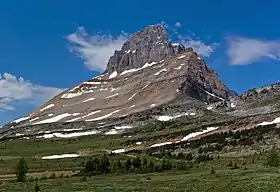Ptarmigan Peak (Alberta)
Ptarmigan Peak is a peak located beside Pika Peak in Banff National Park, Alberta, Canada.
| Ptarmigan Peak | |
|---|---|
.jpg.webp) Ptarmigan Peak (left) seen from Deception Pass | |
| Highest point | |
| Elevation | 3,059 m (10,036 ft)[1][2][3] |
| Prominence | 209 m (686 ft)[2] |
| Listing | Mountains of Alberta |
| Coordinates | 51°29′32″N 116°05′26″W[4] |
| Geography | |
 Ptarmigan Peak Alberta, Canada  Ptarmigan Peak Ptarmigan Peak (Canada) | |
| Parent range | Slate Range Canadian Rockies |
| Topo map | NTS 82N8 Lake Louise |
| Climbing | |
| First ascent | 1909 |
| Easiest route | Moderate scramble |
The mountain was named in 1909 by J.W.A. Hickson after he found several ptarmigan in the meadows below the peak. Hickson also made the first ascent guided by Edward Feuz jr.[5]
The Lake Louise Mountain Resort is developed on the southern slopes of the Merlin Ridge, which includes Mount Richardson, Ptarmigan Peak, Pika Peak. A backcountry campground is located at the foot of the mountain, near Hidden Lake.
Routes
The scrambling route is via southern slopes starting from Hidden Lake.[3]
Geology
Like other mountains in Banff Park, the mountain is composed of sedimentary rock laid down during the Precambrian to Jurassic periods.[6] Formed in shallow seas, this sedimentary rock was pushed east and over the top of younger rock during the Laramide orogeny.[7]

Climate
Based on the Köppen climate classification, Ptarmigan Peak is located in a subarctic climate zone with cold, snowy winters, and mild summers.[8] Temperatures can drop below -20 °C with wind chill factors below -30 °C.

See also
References
- Banff & Mt. Assiniboine (Map). Cochrane, AB: GemTrek Publishing Ltd. 1997. § 6204. ISBN 1-895526-04-3.
- "Ptarmigan Peak". Bivouac.com. Retrieved 2009-01-02.
- Kane, Alan (1999). "Ptarmigan Peak". Scrambles in the Canadian Rockies. Calgary: Rocky Mountain Books. p. 249. ISBN 0-921102-67-4.
- "Ptarmigan Peak". Geographical Names Data Base. Natural Resources Canada. Retrieved 2019-06-08.
- "Ptarmigan Peak". cdnrockiesdatabases.ca. Retrieved 2007-08-31.
- Belyea, Helen R. (1960). The Story of the Mountains in Banff National Park (PDF). parkscanadahistory.com (Report). Ottawa: Geological Survey of Canada. Archived (PDF) from the original on 2015-10-02. Retrieved 2019-09-13.
- Gadd, Ben (2008), Geology of the Rocky Mountains and Columbias
- Peel, M. C.; Finlayson, B. L.; McMahon, T. A. (2007). "Updated world map of the Köppen−Geiger climate classification". Hydrol. Earth Syst. Sci. 11: 1633–1644. ISSN 1027-5606.
External links
- National Park Service web site: Banff National Park